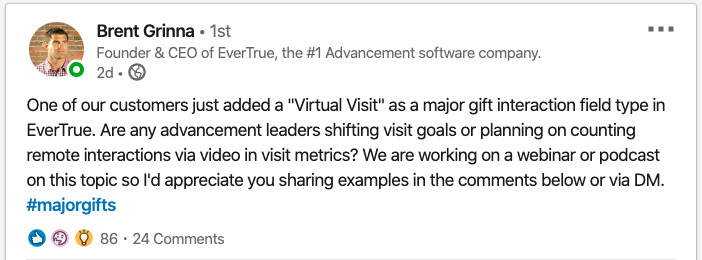Earlier this week, Brent posed a question on LinkedIn about how leaders in advancement are handling changing goals and tracking interactions like virtual visits during this time of social distancing, limited or nonexistent travel plans, and increasing uncertainty.
We’ve gathered some of the most insightful responses to share. Here’s what your peers are doing:
1. Continue to emphasize the importance of relationship building.
Lynette Marshall, President and CEO of the University of Iowa Center for Advancement is “urging staff to continue to make connections in the most appropriate way during this unprecedented time.”
Similarly, Susan Armacost, Executive Director for University Development at The University of Memphis, is expecting “heightened activity” from her staff “but with lowered expectations for proposals and closed gifts.”
Read more about Susan’s management strategies during the COVID-19 outbreak.
We have to agree with both leaders here. It is an excellent time to check in with donors and prospects to build relationships. However, for many donors, it’s likely not the right time to try to solicit large gifts. Relationship-building communications without making an ask will be more valuable than ever for your constituents.
2. Make up for a lack of face-to-face visits with plenty of engagement points.
This is the perfect time for your team to leverage various technology platforms (we listed our personal favorites here) to connect with more donors than ever. Brett Evans, AVP for Development at Baylor University, is pushing his team to use Zoom, FaceTime, or traditional phone calls in lieu of face-to-face visits to connect with donors.
Kristen DeVries, VP of University Advancement and the Executive Director of the Western Michigan University Foundation even has a way for her team to classify meetings as “Virtual Visits” in their system. She’s helping her team to convert the in-person meetings they had already set up into virtual meetings for the time being. We think that specifying interactions as video meetings is especially valuable, as face-to-face conferencing often provides a more personal connection to donors than a phone call, but not quite as much as an in-person meeting.
3. Modify your team’s goals.
The spread of COVID-19 has presented unprecedented challenges to gift officers and front-line fundraisers. Travel concerns and restrictions will have a major impact on their ability to achieve and exceed activity goals set for this time period.
Given the current circumstances, Natalee Martin of UConn Health shared that her team is counting these virtual visits toward their team’s metrics in an effort to “shift fundraising priorities and focus to be sensitive and relevant to our current global climate.”
4. Trust your team. But don’t forget to check in!
“Be patient, be flexible. This is the time to trust your team. I’ve encouraged mine to work remotely. There’s not anything we do that requires our frontline team to be in the office… It’s important for managers to be engaged with their direct reports in intentional ways so that they all feel like they’re part of the team.” – Susan Armacost, The University of Memphis
This is an opportunity for teams to get creative, try new things, and test new technologies. Checking in via Zoom or Google Hangouts can give teams the chance to share new strategies they’ve been trying from their home office.
Eric Holderness, AVP of Development at the Kansas State University Foundation says that daily team check-ins are a way for fundraisers to “steal meetings” from each other. No, not actually stealing prospects, but sharing insights and ideas that work, answering questions, and keeping each other motivated, all of which are critical as we head into uncharted territory.
 Eric Holderness chatting with Mike Nagel via Zoom about how his team is
Eric Holderness chatting with Mike Nagel via Zoom about how his team is
adjusting to remote work.
Read more about how Eric’s team is tackling the COVID-19 crisis and going fully-remote.
How are you tackling the shift to virtual visits? Let us know in the comments.

